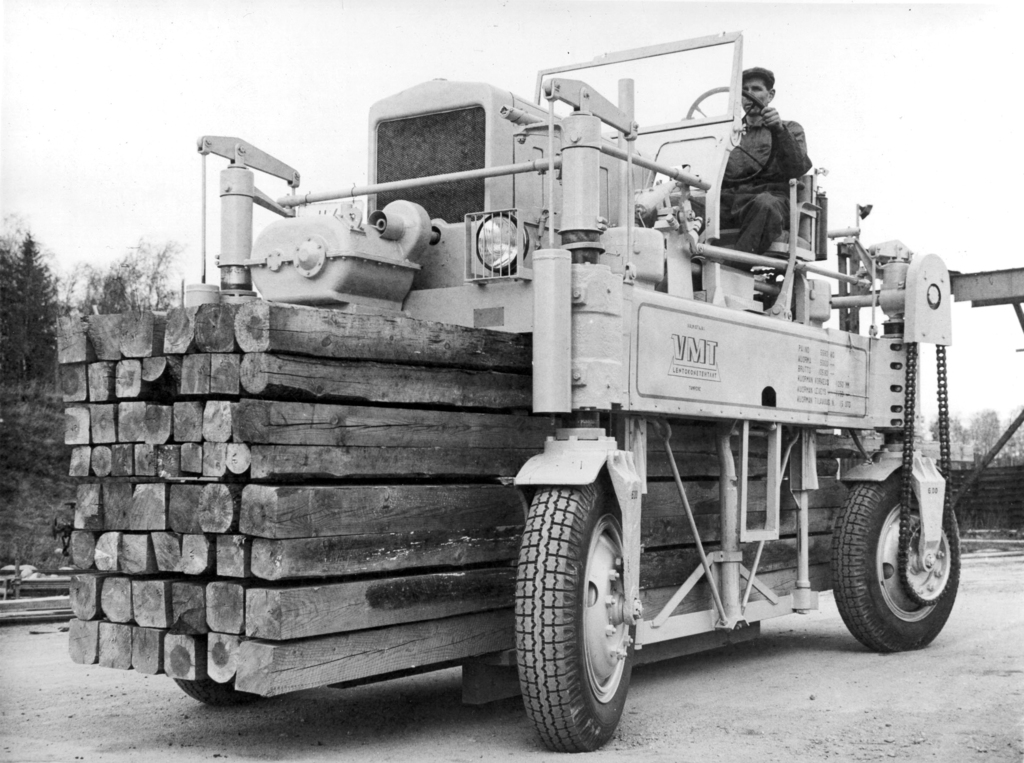
Local innovation, global leadership: The history of Kalmar
Kalmar is the global leader in heavy material handling for ports, terminals, distribution centres, and heavy industry. With a worldwide team of approximately 5,100 employees, Kalmar's history extends back almost a century, through a heritage of companies that have sprung from unique innovation clusters in their respective regions. With roots in Tampere, Finland; Småland, Sweden; Ottawa, Kansas; and The Netherlands, Kalmar has grown through a complex and eventful evolution to become the company it is today.
Finland 1930–1950: From airplanes to straddle carriers
For the earliest chapters in Kalmar's history, we can turn to Finland in the 1930s. The Finnish state aircraft factory built military aircraft on the islands of Suomenlinna and Santahamina in Helsinki, but rising international tensions prompted a relocation of the factory to a more secure location in 1936. The area of Härmälä, outside the city of Tampere some 180 km from Helsinki, was chosen for this purpose. During the Second World War, the company engineered, built, refurbished and serviced all of Finland’s military aircraft for the war effort.
After the end of the war, the aircraft factory was consolidated into the company Valtion Metallitehtaat (State Metal Factories), which was renamed Valmet in 1951. The airplane factory was converted to civilian production, manufacturing items such as locomotives, washing machines, chainsaws and wall clocks.
The instrumentation department that produced various instruments and gauges for military aircraft formed the basis of the future Valmet Process Automation operations in Finland, while the Tampere railway factory would go on to manufacture a wide range of rolling stock including steam, diesel and electric locomotives as well as trams, electric trolleybuses and metro trains. Even today, some underground trains on the Helsinki metro are still those produced in the former Tampere factory.
The first straddle carrier for industrial application was built in Härmälä in the late 1940s. As a part of the war reparations delivered by Finland to the Soviet Union in the 1940’s and 1950’s, Valmet's Härmälä factory produced 500 lumber carriers that were followed by an actual paid order for approximately 500 more units. The lumber carrier was an early precursor of the container straddle carrier that would eventually come to dominate the entire global container-based logistics industry.
Sweden 1949–1975: The village workshop conquers the world
Meanwhile, in the southwestern Småland region of Sweden, another local cluster of industrial innovation brought together several companies whose products would ultimately build into a world-class portfolio as part of today's Kalmar product range. In 1949, a small workshop in the town of Lidhult built its first forklift for use at a local sawmill. The machine was a success, and the company, called Lidhults Mekaniska Verkstad (Lidhult Mechanical Workshop, LMV), began serial production of forklift trucks in 1952.
The roots of Kalmar services also extend to the 1950s. The first service workshop at Lidhult was a simple barn with no sophisticated tools, but in the 1960s the first real workshop was built to service the machines built at the facility. In the early years, a very small local team handled the service and repair of machines in Sweden and Scandinavia, driving from location to location in a Volvo Duett PV445PH station wagon.
By the 1970s, the company had grown to approximately 200 employees, and had successfully expanded its business into port operations with trucks that were able to handle containers inside the newly emerging class of ro-ro ships. The key to this success was a patented solution that equipped the truck with six wheels on the front axle instead of the usual four. Hydraulic push on the outer wheel pairs enabled the machine to distribute the axle load without compromising maneuverability or overloading the deck surface of the vessel during lifting.
LMV had originally been owned by regional forest owners' associations, but in 1974 it was sold to Kalmar Verkstad AB, an ailing state-owned company whose products included railway cars. New international orders for trucks manufactured by LMV played a significant part in the subsequent turnaround of the company. A year later, in 1975, Kalmar Verkstad's product portfolio was further strengthened by the acquisition of Ljungbytruck, a local competitor that had focused on trucks in the 5 to 20-ton range. This complemented Kalmar Verkstad's existing offering of heavy forklift trucks of up to 40-ton capacity. Together, the companies – now called Kalmar LMV – were able to compete on an equal footing with leading US-based manufacturers.
In the 1970s, LMV's service offering expanded along with the first export sales, but service was still mainly focused on supporting the company's products. With the formation of the joint company Kalmar LMV, service and customer support became increasingly important and the company developed its first spare parts warehouse. In the 1980s, development continued with the start of the refurbishment and exchange unit business.
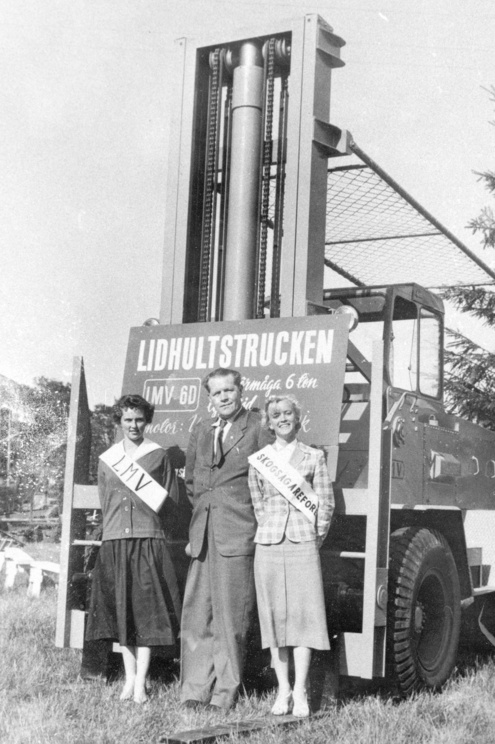
USA 1950s: Inventing the terminal tractor
As a truly global company, today's Kalmar integrates several strands of industrial heritage from around the world. Kalmar's line of terminal tractors originated in the town of Ottawa, Kansas in the central United States in the 1950s, where a small company called Ottawa Steel Products manufactured attachments for farm equipment.
In 1958, Ottawa Steel introduced the world's first terminal tractor for moving trailers in ports, terminals, warehouses and distribution facilities. The company would eventually become the global leader in the terminal tractor business, producing over 85,000 units to date – more than all its competitors combined. Today, Kalmar terminal tractors are still manufactured in Ottawa, in addition to plants in Stargard Szczeciński, Poland and Shanghai, China.
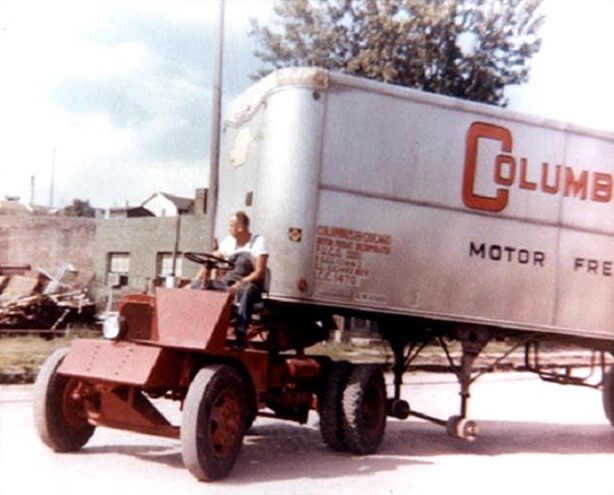
Finland 1970s: Taking on the containers
By the 1970s, containerisation had begun to reshape the global logistics industry, and the first container straddle carriers had appeared on the market. Valmet's first prototypes for container straddle carriers were built in 1976. Featuring the now familiar design of twin engines on both sides of the frame, the machines quickly outpaced the competition thanks to their four-wheel drive. Earlier two-wheel-drive straddles on the market had proven to be unusable in snow at northern European container ports. By contrast, the Valmet straddle carriers negotiated the harsh conditions with ease, and successful first deliveries to Germany and the UK were soon followed by additional orders around the world.
This machine ultimately developed into the Kalmar Classic Straddle Carrier, which became a ubiquitous piece of equipment at ports and terminals worldwide, renowned for its reliability and easy maintenance even in extreme environments. Over 2,500 units were delivered during the following four decades, and a significant number of these machines are still in operation. The Kalmar Classic Straddle Carrier has since been superseded by Kalmar's hybrid and electric straddle carriers, and the last diesel-powered machine was delivered in 2023.
Sweden 1980–1995: Reaching across the globe
Throughout the 1980s, Kalmar LMV saw consistent long-term growth in international markets. By the middle of the decade, the company had sales and service in over 50 countries and produced an unrivalled range of counterweight trucks from 2 to 80 tons. The product portfolio included, for example, the world's largest forklift, the massive 80-ton Kalmar LMV 80-200, as well as the first electric forklifts, first introduced in 1980 in the 2–3.5 ton range, which marked the beginning of Kalmar’s electrification journey.
In 1985, Kalmar completed the world's first prototype reachstacker, and commercial deliveries of the machine began the following year. The reachstacker would go on to become a mainstay of the global logistics industry, with each generation of machines expanding its handling capacity in both payload and reach. Development on the reachstacker was carried out in parallel with the forklift trucks, with a modular approach that enabled the reuse of components between product lines.
By the mid-1990s, Kalmar had reached a strong position in the global market, with a 40% share in heavy forklift trucks and 45% in reachstackers. During the 1990s, Kalmar Services also began to expand beyond just providing spare parts. Kalmar established service units in Scandinavia, Germany, Austria, UK, Hong Kong and Singapore. Spare parts operations were moved from Lidhult and Ljungby to Metz in 2000.
Following several ownership changes in Kalmar LMV, the company, now employing approximately 1,500 people, was renamed Kalmar Industries and listed on the Stockholm stock exchange in 1994.
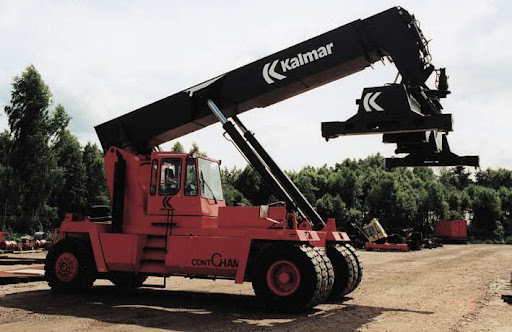
1990–2000: Bringing it all together
In the late 1990s, several mergers and acquisitions took place that would form the basis for the Kalmar that we know today, connecting the Nordic cargo handling lineages of Valmet in Finland and Kalmar Industries in Sweden, with the terminal tractor heritage of Ottawa Trucks in the US.
In 1994, Finnish state-owned corporation Sisu acquired Ottawa Trucks as well as Valmet's material handling business. In 1997, Finland-based Partek, in turn, acquired Sisu Terminal Systems along with a majority share in Kalmar Industries, merging the two companies. By 2000, Kalmar Industries had become fully owned by the Finnish Partek and was delisted from the Stockholm stock exchange.
In 2000, Partek acquired the Swedish container spreader manufacturer Bromma, which would subsequently become part of Kalmar. Founded in 1965, Bromma invented the telescopic spreader, which made it possible for terminals to accept containers of different sizes without changing the spreader for every lift. Today, this basic design still rules the world of spreaders, and Bromma has delivered over 20,000 crane spreaders and rotators to more than 500 terminals in over 90 countries. As a testament to the reliability of Bromma's products, more than 10,000 of these are still in operation today.

2000–2010: Establishing Cargotec
For Kalmar, the start of the new millennium was a period of continued growth and development. In 2001, Kalmar extended its offering through the acquisitions of Dutch ship-to-shore crane and straddle carrier manufacturer Nelcon as well as maintenance company Groot-Hensen. Nelcon was a well-established crane company that was known for its cutting-edge solutions. In the 1990s, the company had already delivered fully automated stacking cranes to Rotterdam, the biggest port in Europe, in addition to contributing to the first fully automated container terminal in the world, ECT Rotterdam. These acquisitions brought to Kalmar strong expertise in the heavy crane business, which would ultimately contribute to the company's development of terminal automation solutions.
In 2002, Finnish lift and escalator company Kone acquired all shares of Kalmar's parent company Partek. A few years later in 2005, another major restructuring took place as Kone demerged its material handling businesses into Cargotec Corporation. At the time, Cargotec comprised Kalmar along with the Hiab and MacGregor handling equipment businesses.
2005 also saw a major milestone in the newly emerging field of terminal automation, as the first fully automated straddle carrier terminal in the world using Kalmar straddle carriers was opened by Patrick Terminals in Brisbane, Australia. The Patrick terminal has delivered solid non-stop performance for close to two decades and has become one of the safest in the world since the introduction of the Kalmar AutoStrad™ system.
In 2006, Kalmar extended its global manufacturing network with the opening of a major factory in Shanghai region in China. The plant manufactures a wide range of high-end cargo handling equipment, serving customers as far as the APAC region, Africa, South America, Oceania and the Middle East. The state-of-the-art plant is renowned for its outstanding safety record as well as its extensive use of innovative digital planning systems. The factory celebrated the delivery of its 3000th reachstacker in 2021.
During the same decade, the electrification of horizontal container transportation began to take shape, with Kalmar introducing the Zero Emission and hybrid RTG cranes as well as the first-generation hybrid-drive straddle carriers.
2010s: Change and growth
In the 2010s, Kalmar, part of Cargotec, once again faced a period of significant changes in corporate and operational structures. In 2010, Cargotec opened a new state-of-the-art assembly facility in Stargard Szczeciński, Poland. Thanks to its strategic location close to European steel suppliers and cost-effective production, the factory proved to be a key factor in Kalmar's continuing success on the global market. In addition to straddle carriers, the manufacture of reachstackers and empty container handlers was moved from Lidhult to Stargard Szczeciński in 2013, and forklift trucks soon followed.
In the first half of the decade, major announcements included the 2011 acquisition of US-based terminal operating systems provider Navis, a move that further strengthened Kalmar’s position as the industry forerunner in terminal automation. Navis was part of Kalmar until 2021. The 2010s also saw the introduction of the Kalmar SmartPort portfolio of process automation solutions for terminals.
In 2012, Kalmar opened its new technology and competence centre in Tampere, Finland, focusing on the development of energy-efficient, safe and intelligent machinery and automation solutions. The same year saw the beginning of operations of Rainbow-Cargotec Industries (RCI), a joint venture established in China for the manufacturing of Kalmar RTG and STS cranes. Kalmar would continue to hold a share in the joint venture company until 2020, at which time Kalmar transferred its intellectual properties and assets related to heavy cranes to RCI. By exiting the heavy crane business, Kalmar turned its full focus on mobile port equipment, shuttle and straddle carriers, and the distribution, heavy logistics, forestry and metal industries. 2018 saw the opening of Kalmar’s newest Innovation Centre in Ljungby. The state-of-the-art facility, employing some 200 people, was designed and built to streamline knowledge sharing and generating ideas across borders.
In 2019, Kalmar introduced its flexible and scalable Kalmar One open automation system for handling containers in ports and terminals. As a standardised open automation system, it is applicable for a wide array of container handling equipment types, and can be seamlessly integrated with other systems through Kalmar Key open APIs. In 2023, Kalmar One was certified for IEC 62443-4-1, the international standard for cyber security in industrial automation and control systems. Kalmar is the first solution provider in the ports and terminals industry to receive the certification for the software development of its automation system.
Powering up with electrification
Kalmar has long seen the future as fully electric, and the company has played a key part in supporting terminal operators and ports in moving towards eco-efficient solutions and reaching their sustainability goals. By 2018, over half of Kalmar's cargo-handling portfolio was available as electrically powered, and the entire product portfolio was available as 100% electric from 2021, including electric reachstackers, heavy, medium and light forklifts, straddle carriers and terminal tractors
In 2023, Kalmar announced the Electric Straddle Carrier Charge Family, the latest addition to its rapidly growing portfolio of fully electric equipment. The Charge Family comprises battery technologies, charging solutions and software to support straddle carrier operators at both manual and automated terminals in their transition towards decarbonised operations.
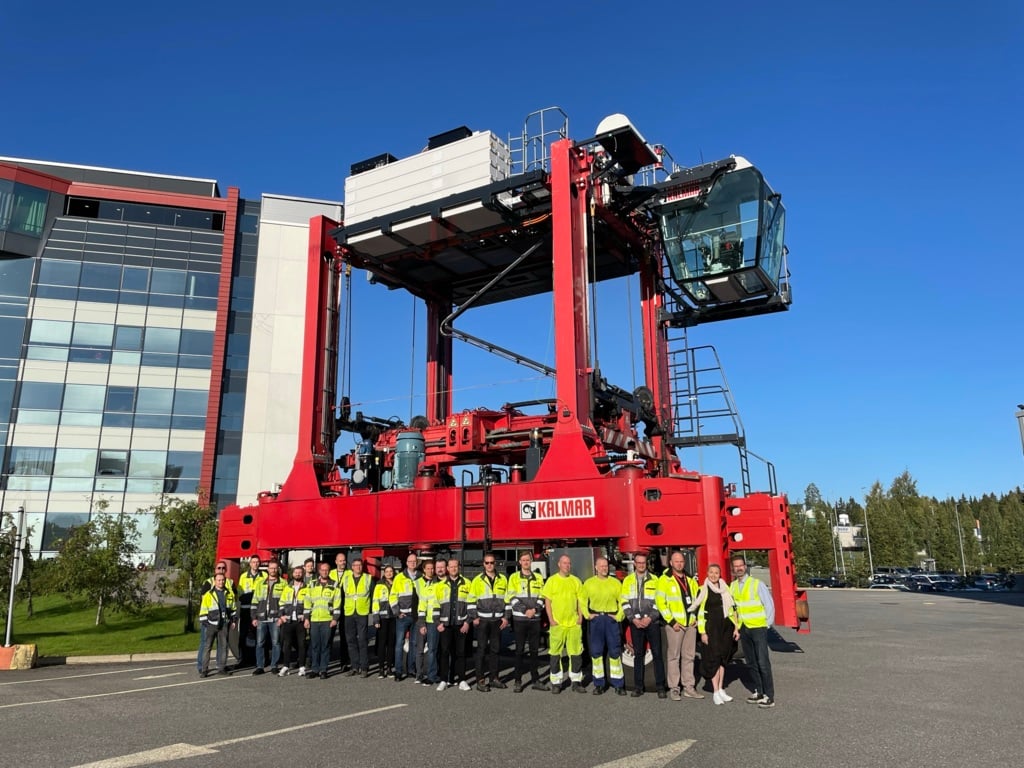
2024 and onwards: Defining the future of logistics
Today, Kalmar continues to lead the way in sustainable material handling around the world with its fully electric portfolio. Over the last decade, electrification has gained ground steadily as operators seek to reduce the carbon footprint of their operations without compromising performance.
Besides electrification, Kalmar has taken further steps in its robotisation journey. In 2024, Kalmar and Forterra signed a joint development agreement for autonomous terminal tractor solutions. Kalmar introduced its Robotic Portfolio in 2021, a future range of intelligent, flexible and autonomous mobile equipment solutions.
In the new millennium, Kalmar Services have also continued to grow through adding new service locations and spare parts distribution facilities around the world, complemented with authorized third-party service representation. Today, Kalmar is the leading service provider in the industry.
Terminal automation and digitalisation are also playing a part in transforming global logistics chains. Connected solutions such as Kalmar Insight turn operational data from equipment into actionable, impactful insights that enhance the productivity, safety, and eco-efficiency of equipment fleets. At the same time, the sourcing of spare parts has become fully digitalised through online platforms such as Kalmar MyParts.
Throughout the decades, the story of Kalmar has been one of local innovations combining into winning products that have found success worldwide. Today, with employees in 30 countries and customers all over the globe, this idea is more relevant than ever. As Kalmar moves towards the next chapter in its history as a separately listed standalone company, the original birthplaces of its product lines – Tampere, Lidhult/Ljungby and Ottawa – remain as its the core innovation and development hubs, ready to face and meet the challenges of the 21st century. Kalmar's vision is to be a forerunner in sustainable material handling equipment and services by focusing on three strategic areas: investing in sustainable innovations, growing services, and driving excellence.
Subscribe and receive updates in your email
Unsere Veröffentlichungen abonnieren


